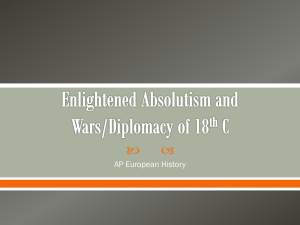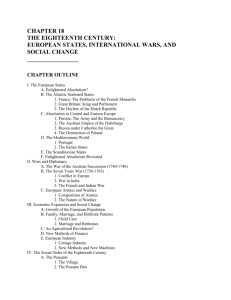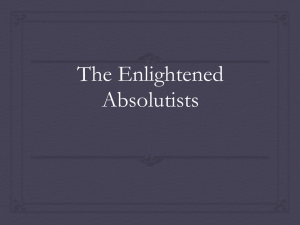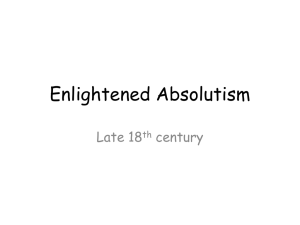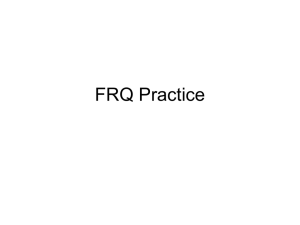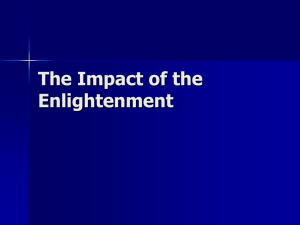File
advertisement
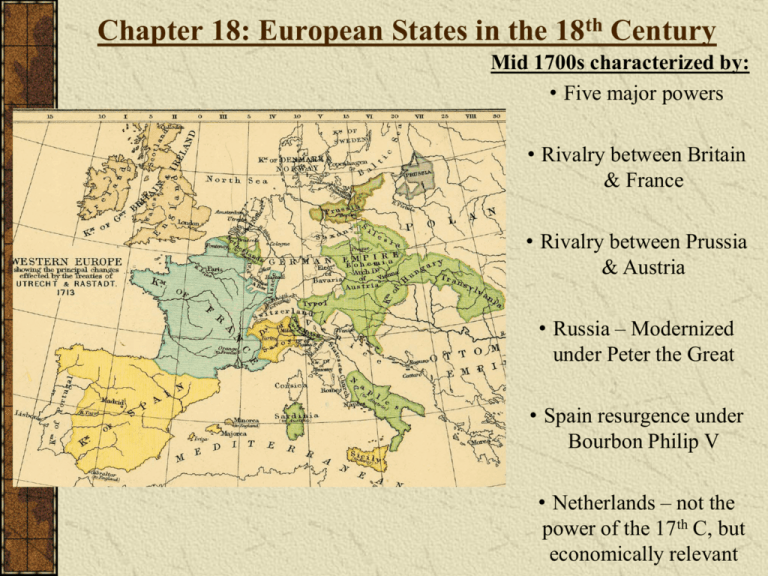
Chapter 18: European States in the 18th Century Mid 1700s characterized by: • Five major powers • Rivalry between Britain & France • Rivalry between Prussia & Austria • Russia – Modernized under Peter the Great • Spain resurgence under Bourbon Philip V • Netherlands – not the power of the 17th C, but economically relevant Enlightened Absolutism: Utilitarian arguments replace divineright Adherence to law Defending state vs. enemies Encouraging economic development/industry Frederick II: “first servant of the state” Enlightenment Ideals/Natural Laws Applied to Governing: Equality before the law Freedom of religious worship Freedom of speech/press Right to assemble Right to hold property Pursue happiness/self fulfillment Tasks of enlightened monarchs 1) protect natural rights 2) foster arts, sciences, and education 3) must rule fairly, not arbitrarily Useful Concept??? The Big Idea: Enlightened monarchs were not nearly as enlightened as previously thought. Enlightened rule in France? No: Louis XIV left enormous debt Louis XV lazy, weak, influenced by ministers and mistresses, lost empire in 7 Years War, court life at Versailles Louis XVI: –lacked knowledge and the energy to solve the country‟s affairs, spoiled wife in Marie Antoinette - out of touch with the countries problems France: The Problems of the French Monarchs RECALL: - Conflicts with Huguenots, - Consolidated monarchy, built Versailles, - Mercantilist state (Colbert), established colonies in New France, commercial output, ineffective tariffs, increased taxes (peasantry) - Enlargement of the army! --- Wars (Spanish Netherlands, vs. Habsburgs, League of Augsburg Spanish Succession) - Depression/famine End of the reign of Louis XIV Enlarged territories Huge debt Surrounded by enemies Unhappy subjects Regency of duke of Orleans and Cardinal Fleury – focus on industry (coal/textiles) and balanced the budget Louis XV (1715-1774) Poor ruler Power to mistress – Madame de Pompadour – resented (bourgeoisie) War of Austrian Succession/Aix-la-Chapelle (land to Austria), Seven Years „War (lost land in Americas) Loss of prestige, debt, taxes, impoverished people Crisis of public finance: “Mississippi Bubble” 1720 (John Law – Mississippi Company issued stocks, underwrite gov‟t debt, reform tax system & make profit – over-speculation led to a boom/bust – forced the state to repudiate its debt France (unlike Britain) did not have public debt funded by banks – debt was king‟s personal debt – insufficient credit institutions/ability to borrow money Assassination attempt - Robert-François Damiens Louis XVI (1774-1792) & Marie Antoinette THROUGHOUT THIS PERIOD: Landed/Commercial classes increasing in power Absolutism est. by Louis XIV - eroding Enlightened rule in Great Britain? ~ Debatable: *Glorious Revolution: power parliament over king *Parliament: make law, taxes, pass budget *Evidence of aristocratic dominance • House of Lords – “Peers” inherited their positions for life • House of Commons – landed gentry (boroughs/counties) Voting, but NOT a “popular vote” – voting rights tied to property *Corruption* Boroughs – voting eligibility varies Use of patronage, bribery, and threats Existence of „pocket boroughs‟ (a.k.a. „rotten boroughs‟) *Duke of Newcastle example (controlled 7 boroughs) Lack of representation for newer, middle class boroughs (Manchester – zero seats…) Counties – 2 delegates from 40 counties – property value of >40 Shillings p. 542 MPs Houses in Borough Voters in 1831 Duke of Rutland 2 35 20 Callington Lord Clinton 2 225 42 Dunwich Lord Huntingfield 2 44 32 East Looe John Buller 2 167 38 Gatton Sir Mark Wood 2 23 7 Old Sarum Earl of Caledon 2 3 11 Newtown Sir Fitzwilliam Barrington 2 14 23 Plympton Earle Earl of Mount Edgcumbe 2 182 40 Borough Patron Bramber Here they are – all good votes – ready to vote for my coach horse if I order them…Give me the money and I‟ll secure you the seat… Well, here‟s the cash… as for the votes, I‟ll leave them to you… Transfer of power from Stuarts to Hanoverians Recall: Test Act (1673) and cause of Glorious Revolution (1688-9) End of Stuart Dynasty • Death of Queen Anne (1714) w/o a direct heir • Desire to avoid Catholic James III • Invitation to protestant, George I of Hanover Coat of Arms House of Hanover Expanding role of chief or “prime” minister under Hanoverians Importance of patronage to monarchy Absence/inexperience of George I and George II • Reliance on PM as main dispenser of patronage George III (1760-1820) ** Early prime ministers • Robert Walpole (1721-1742) Peaceful foreign policy/no new land taxes • William Pitt the Elder (1757-1761) Acquired Canada/India – Seven Years‟ War • Lord Bute (1762-1763) Brought in w/ new king, George III Growing middle class discontent w/ electoral system, loss of American colonies – criticism leads to appointment of William Pitt, the Younger (1783) Enlightened rule in the Dutch Republic? No: REMEMBER – wars in the late 1600s with France (Louis XIV‟s Dutch War) & conflict between: • Oligarchs (States General – Dutch Towns - republican) vs. • House of Orange (Monarchy – Stadholders) …Still on… NOW • “Regents” (Oligarchs – Dutch Towns) vs. • Stadholders (Executive Branch – House of Orange) • Rise of “Patriots” (artisans, merchants and shopkeepers) pushed for democratic reforms Prussian king sent troops in to crush the Patriots who were a threat to his sister (wife of an Orange stadholder) Old order reestablished Enlightened rule by Hohenzollerns in Prussia? Some reforms, but no: RECALL: Emergence of Brandenburg-Prussia (1648), Frederick William, est. of the War Commissariat, Frederick III “King Frederick I” (helped Austria in the War of Spanish Succession), Junker power/suppression of peasantry Prussia: The Army and the Bureaucracy King Frederick William I (1713-1740) General Directory – admin. Central gov‟t (military, police, economic/financial affairs) Civil Service Workers – service/loyalty to the state – military virtues (duty, obedience, sacrifice) Prussian militarism – “not a country with an army, but an army with a country which served as headquarters and food magazine” Rigid social classes • Junkers: owned land (serfs), military officers • Peasants: serfs-dependent on Junkers • Middle Class: civil servants – could earn high posts (non-noble birth) Frederick II (1740-1786) “Frederick the Great” Connections to Voltaire/philosophes Relationship with father? (p.546) Role: “first servant of the state” Prussian bureaucracy: professional, efficient, honest, obedient Single code of laws – limited use of torture Some free speech/press Religious toleration …. BUT Did not interfere with Junkers‟ hold on serfs More aristocratic – reversed merit system and installed nobility Enlarged the Prussian Army Took Silesia from Austrians • War of the Austrian Succession • Seven Years‟ War Partitioned Poland (Austria/Russia) 1772 Enlightened rule in Austria? Temporarily, Yes – Joseph II, but ultimately, no: Maria Theresa (1740-1780) Catholic and conservative Joseph II (1780-1790) “tried to push through reform with a steamroller” *alienated the nobility by freeing the serfs, alienated the church by his attacks on the monastic establishment, serfs were unhappy and unable to comprehend the changes* Reforms were rolled back by successors. The Austrian Empire of the Habsburgs Diverse Empire – Vienna – cultural capital Maria Theresa (1740-1780) Catholic & Conservative Loss of Silesia to Prussia leads to a push toward centralization • Reduced power of diets in the provinces (less taxation/local admin.) -Income/property taxes from clergy and nobles to royal officials • Reorganization of territories into royal districts • Modernization/build up of military Limited response to calls for reform Joseph II (1780-1790) - more reform-minded Continued Centralization trend Educated – enlightenment-influenced Abolition of serfdom – hereditary land rights Penal code – equality before the law/elimination of death penalty Complete religious toleration German as official language 6000 decrees/11,000 laws BUT Alienated nobility and the church, non-German speakers, even serfs Reforms did not largely take hold Russia Under Catherine the Great, 1762-1796 Peter III (murdered) – German Wife – Catherine Learns Russian Educated (Enlightenment-minded) – (Voltaire/Diderot) Reforms Election of an assembly in 1767 – new law code Questioned practices of serfdom, torture, capital punishment, advocated equality before the law Result – little change b/c Strength of land owning class (Boyars) Reorganization into 50 provinces, subdivided into districts – officials chosen by Boyars Nobility formed corporate groups w/ privileges (trial by peers, exemption from personal taxation, corporal punishment) Privileges formalized in the Charter of Nobility (1785) ---- peasants suffered Pugachev‟s Rebellion (1773) Emelyan Pugachev – support by Cossacks Spread throughout Russia Manifesto 1774 – freedom from oppressive taxes/military service 1,500 estate owners killed Rebellion crushed, Pugachev executed RESULTS: Greater repression of peasantry (rural reforms halted, serfdom expanded into newer parts of Russian Empire) Pugachev’s Rebellion Catherine the Great - Legacy Reform minded – blocked by reality – nobles kept privileges Expansion of Russian territory westward into Poland (eventually 50%) and southward to Black Sea (Ottoman Turks) *Treaty of Kuchuk-Kainarji* Enlightened reforms in Poland? No: Polish king was elected by the nobles and was forced to accept drastic restrictions on their power including limited revenues, a small bureaucracy, and a standing army of only 20,000 soldiers 1772, 1793, and 1794 Austria, Prussia, and Russia divided up the weak country The Destruction of Poland REMEMBER: The Electoral Nature of the Monarchy (Sejm) did not have an absolutist state Limited bureaucracy and ARMY Weak decentralized state Division of Polish Territory – Balance of Power (Austria, Prussia, Russia) 1772 – 30% of land 50% of population – given up 1792 – Russia and Prussia (w/ Austrian support) - 2nd partition Polish rebellion under General Thaddeus Kosciuszkol – crushed and the rest of the state was overtaken (1795) Brought Russia into European State system Cynical nature of the balance of power The Mediterranean World Enlightened rule in Spain? no: The monarchy was “Bourbonized” (centralized) … Jesuits were banished and the Catholic Church was brought under control but the landed aristocracy continued to exercise substantial power REMEMBER – when did we last see Spain? – Treaty of Utrecht (1713 – end of the War of Spanish Succession) Habsburg to Bourbon – more centralized state – Philip V (1700-1746) Laws/institutions/language Castilian Royal bureaucracy established – ministries/intendants Easier to maintain – Utrecht (loss of Italian lands and Netherlands) ----------------------------------------------------Charles III (1759-1788) – Catholic Church under state control Banished Jesuits Constrained the Inquisition ….Still – powerful aristocracy Portugal Enlightened rule in Portugal? no: In Decline Pombal (1699-1782) – Chief minister to Portuguese kings, nobility, Church Portuguese Empire temporarily revived Once removed from office – nobility/church gained power The Italian States Enlightened rule in the Italian states? No: Italy remained fragmented into several states which allowed Austria and Spain to have control over much of the area Utrecht – Austria took Spain‟s territory in Italy (Milan, Sardinia, Naples) Savoy (N. Italy) – Sicily – expansionary 1734 – Bourbons of Spain – reestablished control over Naples and Sicily Other states: Venice, Genoa, Papal States – Independent Decentralized The Scandinavian States Sweden Was there Enlightened rule in Sweden? Close: King Gustavus III (1771-1792) implemented freedom of religion, speech, and press, new code of justice that eliminated the use of torture, laissez faire reforms: reduced tariffs, ended tolls, and encouraged trade/agriculture, the King was killed by nobles who tried to reinstall their power with limited results Had been dominant in Scandinavia Declined after Battle of Poltava 1709 Death of Charles XII (1718) Nobility reasserts control pro-French vs. proRussian factions King Gustavus III (1771-1792) Able to take control of Swedish diets Enlightened monarch? • Freedom of religion, speech, press • Code of justice – elimination of torture • Laissez Faire economics: reduced tariffs, abolished tolls, encouraged trade/agriculture • Assassinated after a masquerade ball! Denmark Enlightened rule in Denmark? No: King Christian VII (1766-1808) tried reforms but stopped after his chief minister John Frederick Struensee was killed because of aristocratic opposition Enlightened Absolutism Revisited Comparing Joseph II, Frederick II, Catherine the Great (Joseph II) Needs of state, dependence upon nobility Need for centralized state power/bureaucracy/taxation – national armies Some legal reform, installation of rights, religious toleration, education Changes limited to bureaucracy, administrative and judicial systems STILL – hereditary aristocracy maintained a lot of power/rights/privileges Enlightenment reforms ultimately held back by landed aristocracy Wars and Diplomacy Concept of Balance of Power – prevent one state from becoming too powerful – not a desire for peace – expansionism the norm TRANSITION Dynastic interests dominated diplomacy – expansion of dynastic holdings to raison d’état – Reason of the State Development and centralization of the modern nation state closely linked with winning wars and maintaining standing armies Europe Before the War of Austrian Succession (1740) The War of the Austrian Succession (1740-1748) Habsburg Charles VI (1711-1740) dies Pragmatic Sanction – for Maria Theresa Maria Theresa(daughter) vulnerable Frederick II invades Silesia France sides with Prussia Britain sides with Maria Theresa/Austria France invades the Austrian Netherlands, took Madras (India) from Britain Great Britain takes Louisbourg (St. Lawrence R.), Canada from France 1748 – Peace of Aix-la-Chapelle – virtually all territories returned Except… Silesia kept by Prussia – tension remains Prussia‟s power status recognized Seven Years’ War, 1756-1763 1st truly global conflict Maria Theresa builds army with the intent of retaking Silesia – worked through Count Wenzel von Kaunitz to separate Prussia from France 1756 – Diplomatic Revolution: 2 ½ C. old Bourbon-Habsburg rivalry eclipsed by BritainFrench/Austrian-Prussian rivalry Reason of the State Austria allies with France (also Russia) • Cemented by the Maria Theresa sending her daughter Marie Antoinette to wed future king, Louis XIV (France) Britain shifts to support Prussia (to oppose chief rival, France) ©2003 Wadsworth, a division of Thomson Learning, Inc. Thomson Learning ™ is a trademark used herein under license. The Battlefields of the Seven Years’ War Seven Years’ War: Conflict in Europe Britain although it subsidizes Prussia – focuses its military efforts in Americas/India Prussia surrounded and position desperate in spite of victory at Rossbach in 1757 – eventually worn down “Miracle of the House of Brandenburg” 1762 – Russia withdraws • Tsarina Elizabeth of Russia died – Peter III (nephew) left the war b/c of admiration for Frederick the Great and Prussia w/ Russia gone – stalemate War ends in 1763 w/ Treaty of Hubertusburg (coincides with Treaty of Paris) Seven Years’ War: Conflict in India Madras had been returned to Britain at the end of the War of Austrian Succession Britain & France each supported different Indian princes British forces under Robert Clive took control of French bases and defeated Indian princes Treaty of Paris in 1763 – India left to British Seven Years’ War: The French and Indian War In 1754 – clashes between Britain and France for control of St. Lawrence / Great Lakes (Louisbourg and other forts) and Ohio River Valley French forces pushed out of the north into the garrisons along Mississippi – forts from Appalachians to Mississippi – threatened British colonial expansion French allied with Indians – a way to repel British colonial advance – France less threatening British troops took Fort Duquesne in 1758 and build on the spot Fort Pitt (Pittsburgh) In 1759 – British forces capture Quebec, Montreal, Great Lakes, Ohio Valley / French Caribbean Islands Treaty of Paris 1763 – Britain gets Canada and lands east of Mississippi from France, Spanish Florida from Spain, French give Louisiana territory to Spanish End of New France Eviction of Acadians (Cajuns) to SW Louisiana “Great Expulsion of 17551763” 1/3 of 14,000 perished – ethnic cleansing by British? England – greatest colonial power Remnants of Fort Duquesne (downtown Pittsburgh) …in North America • aka “French and Indian War” • Pitt the Elder’s desire to expand British colonial empire • Successes of British navy; effect on French armies Treaty of Paris Canada/E. of Miss. – FrBr Florida – Sp Br Louisiana – Fr Sp European Armies and Warfare Professional standing army Increase in size – 1740 - 1780 French army: Prussian army: Austrian army: Russian army: 190,000 – 300,000 83,000 – 200,000 108,000 – 282,000 130,000 – 290,000 European Armies and Warfare Composition of Armies Officers – Nobles Rank & File – Lower classes Peasants – generally – farmed Use of foreign troops (Switzerland, German states) Britain alone – no standing army – relied on mercenaries (Hessian troops) French & Austrian Armies – Natives – 6 year terms Unemployed – means of escape Growth of Navies – British/Dutch – scurvy/saurkraut! American colonial mage showing Hessian soldiers as heartless warriors. The Nature of Warfare War – less ideological (vs. religious wars of the 16th/17th Centuries) – less violent Destruction of taxpayers – foolish Warfare based on limited objectives – too costly Less direct confrontation in favor of generals outwitting enemy – use of artillery System of formalities – allowed defeated opponents to withdraw without capture/destruction Use of fortresses – sieges – predictable patterns Surrender of Lord Cornwallis at Yorktown Economic Expansion & Social Change Steady Population Growth after 1750 / Falling Death Rate 1700 – 120 million 1750 – 140 million 1790 – 190 million • more plentiful food • better transportation, • improved diets • new crops from the Americas (potatoes, corn) • End of the bubonic plague • 1750 – farmers producing 50% more food than needed (up from 20-30% around 1700) • Ideal growing conditions Family, Marriage, and Birthrate Patterns Patriarchal institution – women/children property Arranged marriages – interests of family Read 555! Child Care Views on breastfeeding – lower class women did it – upper class women saw it as undignified Use of wet nurses Childhood as a phase of human development – games/toys Primogeniture – under attack Appeals for all women to breast feed Children – a source of anxiety (mouths to feed, risk in pregnancy) Infanticide – dropping children at foundling homes (1/3 of babies in Paris in 1770s!!!)– law in Austria banning children under 5 to sleep w/ parents Foundlings – high rate of death (50-90% mortality) as infants – poor children suffered Marriage and Birthrates Newly weds – independent of parents households Marriage – relatively late mid-late 20s Illegitimacy increases by end of 18th C. Avg. – 5 births/family BUT 40-60% of fertile aged women not married at any given time – the average fell from 1650-1800 Coitus Interruptus Women & children contributed to family economy An Agricultural Revolution? 18th C. Agriculture • More farmland • Increased yields/acre Open Field crop rotation Jethro Tull – experimentation w/ hoe and drill to plant seeds • Healthier/more abundant livestock Selective breeding Roots available from new crops during winter as fodder for animals Animal manure – more fertilizer • Improved climate – “little ice age” declined in 18th C. • New Crops – potato & maize after 1700 Enclosure Movement – Development of Capitalism • End of Open Field System – Enclosure Movement Denial of peasant farmers access to “Commons” – mowing for hay, grazing lands, collecting firewood – stripped of “gleaning rights” Inability to produce legal documents proving ownership Large estates developed Small farmers – wage laborers/tenant farmers Destroyed traditional patterns of English life Increase in productivity Relationship between property/power? New Methods of Finance Shortage of Gold/Silver New Public/Private Banks Use of Paper Notes – Expansion of Credit Bank of England – lent to government Issuing of bonds – interest Public/National Debt vs. Personal Monarch Debt Creation of credit markets – leads to speculation “Mississippi Bubble” France and the “Mississippi bubble” (1719-1721) Bubble: an unusually rapid increase in the value of an asset, followed by an equally rapid collapse • Modern day examples: technology stocks, housing Recall: financial problems left by Louis XIV, France‟s possession of Louisiana territory Lack of knowledge among most French about Louisiana John Law • Duke of Orleans (regent) 1716: opening of Bank Royale to help French economy • Issuance of paper currency 1717: creation of the Mississippi Company • Granting of monopoly over North American trade • Later winning of control over all French inter-continental trade 1719: tying together of Bank Royale and Mississippi Company John Law The bubble forms Jan 1719: 500 livres per share Feb 1720: 10,000 livres per share The bubble bursts Impact Sept 1721: 500 livres per share Failure to develop a national bank in France or to establish public borrowing/debt Dutch power waned – Dutch Capitalists – became financiers of other countries‟ capitalists European Industry Textiles (wool – majority) Cottage Industry Production of textiles in countryside Capitalist-merchant entrepreneurs in cities – used labor of countryside – spinning/weaving in their own cottages – supplemental income Textiles sold at a profit New Methods and New Machines Cotton as a new substitute to wool From India – cheap – slave labor Unable to keep up with cotton demand until – flying shuttle, water frame (Horse/water power to make yarn -- Richard Arkwright), later mechanized looms invented in1780s – used in early 19th C., cotton gin Rural workers – saw new machines as a threat (READ p. 561) Mercantile Empires and Worldwide Trade Commercial Capitalism Integrated markets Joint stock companies Banking/stock exchanges Mercantilist theory – required colonial expansion – globalization • Majority of trade – intraEuropean, but international trade growing • Growth of slave trade – plantation economy • Cheap labor fueled growth of Atlantic States Britain – increased trade with colonies // increase in size of fleets of merchant ships/trade Greater prosperity for Atlantic cities – trade industries (dock workers, tradesmen, servants) The Social Order of the Eighteenth Century Patterns of society Forces of change The Peasants General situation Compulsory services Importance of the village Domination by wealthy landowners The Nobility Privileges of the nobility Military service Moving into the ranks of the nobility Inhabitants of Towns and Cities Townspeople still a minority of the population Importance of towns Centers of culture Urban oligarchy Middle class Petty bourgeoisie Laborers Sanitation and poverty Discussion Questions How did enlightenment ideas help form Enlightened Absolutes in Europe in the 18th century? What do you think are the reasons for the rise of enlightened monarchs in Central Europe? Who was Frederick II and what was his impact on the history, culture and laws of Europe? What started the Seven Years War? How did the war progress and ultimately who won? What were some of the changes in social order in the 18th century? Web Links Louis XIV Frederick the Great Catherine the Great Maria Theresa Seven Years War Pre-enlightenment Europe
